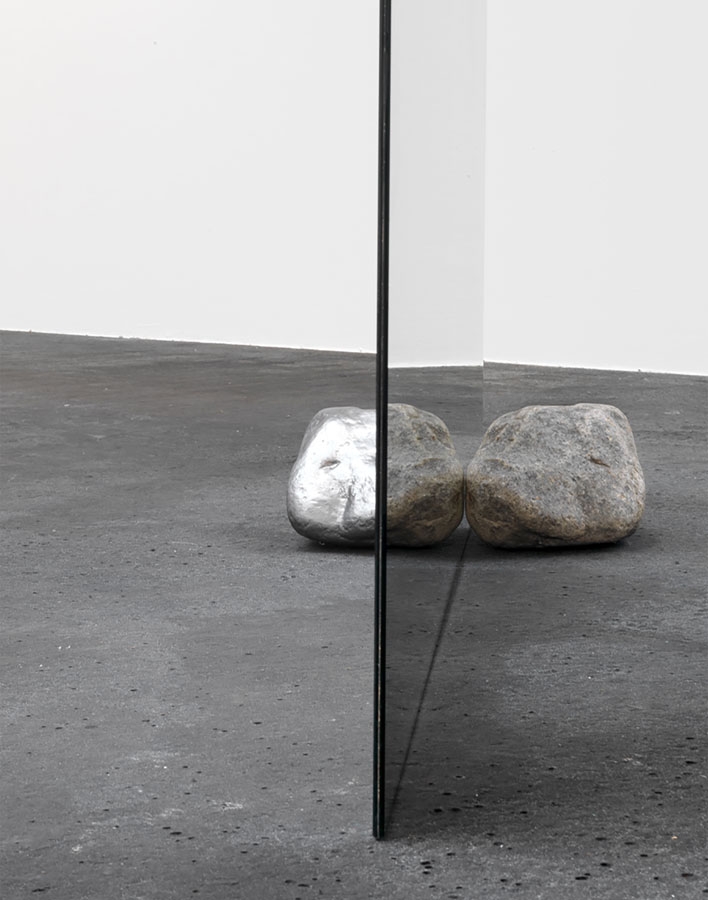Alicja Kwade will be presenting Out of Ousia as part of Art Basel Unlimited, with Kammel Mennour, Paris, and König Galerie, Berlin
You’re making a new work for Art Basel Unlimited, can you describe what ideas you were thinking about when you thought of this work, and how it relates to the meaning of its title, Out of Ousia?
The title Out of Ousia translates loosely to ‘out of the substance’ – the term, ‘Ousia’ stems from ontology, the ancient Greek philosophical study of the nature of reality and the possibility of alternate realities. I hope that the work will leave the viewer thinking about what his or her reality is, and how this experience can be seen in itself as a physical entity. I also want to consider if the goal of art is the ‘Third Table’ as Graham Harman maintains (in his book of the same name published for Documenta 13). As opposed to the physical version (made of atoms and empty space), or the socially used and described version of a table (or any object), this ‘third’ is something else – a philosophical object, the ‘true’ object.
The term, ‘Ousia’ stems from ontology, the ancient Greek philosophical study of the nature of reality and the possibility of alternate realities
What is the relationship to this work and your series of sculptures that you have titled Paravents?
There are no sculptures formally titled Paravents, this was just a working title. Titles are very important in my work, I am always trying to give a link to the concept and the thoughts behind the piece. I am sure you mean the big installation that consists of three parts, which I created for my current show at 303 Gallery. These works are called (1.) I rise again, (2.) changed, and (3.) But the same. ‘I rise again changed but the same’ is a saying of Jacob Bernoulli, a mathematician who was, among others, very important for the advancement of probability calculation, which I am also very interested in.
Your use of mirrors to divide space and also appear to double it can create an experience of time and space that can often be more circular than linear. What sense of time and space will be created by this work?
The viewer will never be able to see all of it at once, which is to say our experiences are always limited to what our senses allow us to take in at a given moment. Time and vantage points are always shifting, and so the ‘truth’ always looks very different.
Your work engages with reality in terms of the perception of space and the objects within it. What additional considerations do you have to take into account when making a work to be shown within the very particular structure of a large and busy art fair?
I am trying to utilise the short attention span that viewers often have at such a fair for the work, for my intention
I combined the elements with the strong form of the wall, which I hope will help the sculpture to physically persist. I am also trying to utilise the short attention span that viewers often have at such a fair for the work, for my intention. I am very satisfied when people do not see at first glance what it is, that some parts are identical but reflected, when they are not sure if this was just their memory or the thing itself, and if something was a reflection or a physical thing… in the best case it’s more like a déja vu feeling… But it’s difficult to say if it will work ahead of time.
The value of everyday objects and materials is an important element of your sculptures and installations – concrete, wood, iron, stone, brass. What influences your choice of materials to use in a particular work or series of works?
This is very different and depending on each work, the material is always very important for me, because the choice of a material is already bringing an interpretation with it.
I like clear-cut materials, they should be what they are….
In works like Goldvolks or the metal sheets pieces, which examine and portray the circumstances of the metal market, it is important to have the pure metal, no alloys, because the work is all about how the value of these heavy elements is created, which is one aspect of their reality.
The Unlimited piece deals more with a transfiguration process, the body of an object stays but is transformed into a different reality or different possibility of itself, which is dealing with the idea of different dimensions but also with the idea of alchemical transmutation.
Can you tell us something about what the focus of your next new project will be and what is exciting you most about it?
I am creating a very new work for the Whitechapel Gallery, London; it’s based on an older work which I did in academy, but in a very new form. It includes sound and moving image, and is not easy in terms of the technique, but I am looking very much forward to it.
Read our cover feature on Alicja Kwade from the December 2013 issue
Read more Art Basel questionnaires
10 June 2016.
